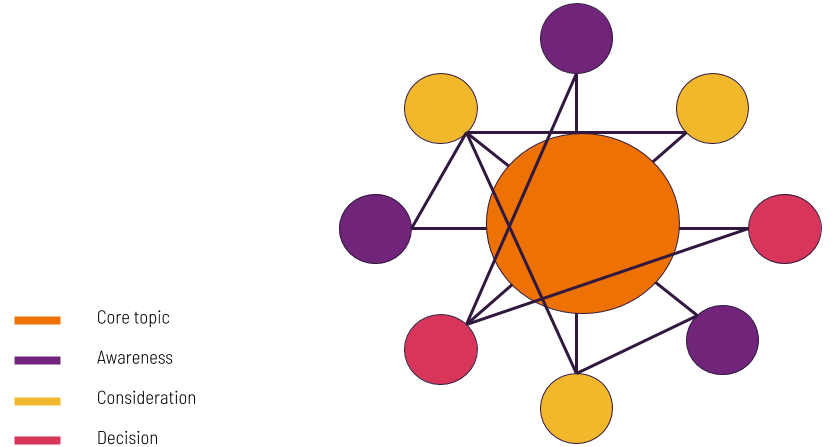Can your business afford to exclude video content from your marketing?
That’s what I’m exploring this week with my very special guest Justin Wastnage, the founder of Vloggi and the person that coined the term Vlog.
In Vloggi, Justin has created the world’s simplest video blogging platform that allows brands and communities to create their own vlog or crowdsource video content.
Did you know, because of its visual nature, 80% of users can recall a video ad they’ve seen in the past 30 days?
Table of Contents
ToggleIn my conversation with Justin we cover a wide range of topics including how to produce highly customised videos for your marketing on a small budget, developing a minimal marketable product and why a picture is worth 1,000 words, and video is worth 1.8 million words.
So please enjoy this special video episode with Justin Wastnage.
What you will learn in this episode

- How to produce highly customised videos in your marketing on a small budget
- How Justin built the Vloggi app
- Developing a minimal marketable product
- How talking to customers can change your product roadmap
- Why videos are such a powerful part of your marketing mix
- How to overcome the barriers to entry to make videos for your business
- If a picture is worth 1,000 words, a video is worth 1.8 million words
- Why a founder can’t do everything in their business
- The benefits of having marketing advisors
Resources mentioned
Get a free Vloggi template for your business by messaging Justin on LinkedIn
Because of its visual nature, 80% of users can recall a video ad they’ve seen in the past 30 days
What business you would build on Mars?

Well, interesting. I was reading about this last week. The current theory is that they’re going to have female only crews go to Mars. This being so because the only way to control human desires is to exclude men, basically. And I think the project could be jeopardized if you had men up there, who wanted to procreate. So, they’re going to take up with them lots of frozen sperm from earth, and assuming that Elon and I get killed, so we are on the first flight, but then they implement the female only plan. The business that we were set up before we get killed is an AI-driven sperm banks.
Kind of like a dating agency, kind of like a bumble or soulmate finder that actually matches the right sperm to the right female scientists up there. And this will be done not only… So how it will be marketed will be some of the profiles and the pictures, but actually behind the scenes, we’ve all done the analysis on the women to find out actually we need very tall people over there to do this bit of work. We will only preselected the sperm on board, marketing it to the women is another matter. But the AI engine behind the scenes is we need a success rate of kind of 75% on these impregnations and I’m not sure how you do it, but I’ll leave that Elon.
Get in touch with Justin
Transcript

Brendan: Justin, welcome to the show.
Justin: Thank you. Nice to be here.
Brendan: So tell me a bit more about Vloggi.
Justin: Vloggi is a collaborative video production platform, and it’s really based a sort of community storytelling. In some ways, the problem that we solve in community storytelling is that it’s very difficult to have multiple voices in multiple locations with multiple perspectives using traditional video editing, and that’s really the problem that we solve.
Brendan: Tell me about the moment that you realized that video was the future. I mean, you were early adopter of online video?
Justin: I was actually. In fact, it may be true that I invented, or was one of the first people to coin the term vlog or video blog. So, basically 20 odd years ago, I was making video case studies for Microsoft. And then I went from there back to being a journalist, and I’d started both the podcasting unit of a publishing house and also the video unit.
Justin: And initially we had a crew of five, we had a sound recordist and a cameraman and a producer and a presenter. And then the next one we did was four, and the next one we did was three. Of course, we had to rely on getting corporate sponsorship for each production in order to… Actually, we used to go to airshows and film them. But then there’s one airshow that they didn’t get a very large advertiser, and it was in Orlando, Florida. And I was going anyway. So, I said, look, I always do it myself. So I basically, on the flight over, composed the theme music, did all the graphics and I filmed everything, did the pieces to camera, walked around the plains and then edited it at night and put up on this thing that at the time called the YouTube, which my editor was skeptical of, I was like, “We want to host everything on our websites.”
Justin: “No, no you don’t. You want to have it on YouTube to get the reach.” And I called it a video blog. And he was like, “Well, what are you… I don’t even know what a blog is, let alone a video!” And that was 2002, I think, or 2003. So when you look back, there were a couple of people using the term before me, but not many. So I was definitely one of the pioneers.
Brendan: Wow. And how did you, I guess, realize this insight that online video is going to be massive?
Justin: That was the start of it, but I’ve always dabbled in film making and have won some awards for short videos and stuff. But then really working in the tourism industry as a consultant, which was up until five years ago as director of tourism Think Tank. And then I did that on my own for two years.
Justin: And basically the challenge that everyone faces in tourism, as an industry, is that they need video and hours and hours of it. Not only for every location, but for every niche audience and for every social media. So at the moment, tourism videos are still fairly generic. It’s a drone shot over the most beautiful thing. It’s a couple of clinking glasses, because the cost of videos are so high that you have to do a fairly generic video. But yet what they wanted was… I was speaking at a conference in Nelson, New Zealand, and met up with tourism board there, and they said, “What we really need is by a world, we would have a video series for disabled travelers, because that’s one target niche of ours.” But yeah, the cost would be too high. So instead we’re going to have to spend 70 or $80,000 getting a generic tourism video.
Justin: So I said, “Hold on, but everyone carries around iPhones?”, And at this stage iPhones weren’t… Well everyone carries around phones, but they weren’t necessarily high definition video cameras. So, that was where the idea really implanted. And I kicked it around, and I’ve got a prototype of a sort of a video capture and collection tool to try and make 90 second videos, and prove the concept, and prove that you could do it remotely without having to, in many different locations. And that was two and a half years ago, when we built the first prototype and basically we’ve been trying to do it ever since. And battling with bandwidth issues and all sorts of issues which affect video, which actually is why it’s so complicated and expensive and hopefully we’ve cracked all those.
Brendan: Right. So can you talk us through the app development process? I mean it looks like you’ve started the correct way of proving out the concept with a MVP or a low fidelity prototype. What happen next?
Justin: Definitely low fidelity prototype. So the first one was, I basically modified Typeform to handle video files. So I hacked the code there and built a front end. It was a responsive website that basically handled bits of video. Then we assembled, we faked it initially, assembled it into 90 second short video programs. Then we built the first actual working app that basically automated that capture thing. So what we actually wanted to do… One problem that we found in the prototype phase was the quality of video wasn’t consistent.
Justin: So we actually needed to do some stuff. And this is part of our sort of IP in the app, is we control the lens of the camera rather than… we don’t actually use the camera app. We use lens, enables us to do more stabilization and color saturation and color correction. We essentially grade the video using AI within the app itself to be consistently high quality videos from anyone who’s using it. So, that capture component actually took us about a year to actually do.
Justin: So, that didn’t leave much time to do the UX. And as a result, the user experience of the existing apps still isn’t where I’d like it to be. But it is very much now is MMP, is what we think of it now. Is the Minimal Marketable Product. So we reached MVP stage about December last year. But there was still lots of features that we had sort of promised and we’ve spent the whole time talking to lots of customers. And initially we looked at just the tourism industry, but then we actually realized that anyone who needs to tell stories in a community, and again, those things I mentioned, if you need to combine multiple locations, multiple points of view or multiple perspectives, then there isn’t really a tool out there that does that.
Justin: There are a thousand video editing apps, some of them better than others. That isn’t the market we’re competing in, which we kind of thought we were initially. But in some ways we are competing with other collaboration tools we’ve realized like Slack, not that we’re competing with Slack, but any… so we’ve broadened our market much bigger than just traveling tourism, even though that’s where the use case came from.
Brendan: Why are videos so powerful?
Justin: Well, videos have and about 80% retention rate in people’s minds about three days later. So if you read something on a page, about 20% of people recall that information three days later, 80% recall that if it’s a video. So actually the old adage that a picture is worth a thousand words. People have been trying to do some metric but we think that video is worth about a million words.
Justin: But even so, I mean, video has that… If you look at how particularly young people consume information these days, it’s very visual and it’s very video-led. But yet, the real target market for us, which is online communities or small businesses who want to use their own customers in their video marketing, and for people who want to tell authentic stories as opposed to pure marketing videos. Because, the other thing which we’ve realized along the way is that actually people don’t like adverts. People want content. This is a content marketing tool, which happens to be video, but it could be just an… So this is why we called it Vloggi in the end. Because, the most compelling analogy was the blog. Actually people who are in content marketing stuff, their pages full of useful content and this is what we’re doing in video form.
Justin: We are allowing businesses to make not just one or two videos but massive volume of video. Because, they set the parameters once they set the branding and then they let their audience, their customers actually make the content for them and the degree of control they have is up to them.
Brendan: Right. So they can select the best content that their audience takes. And then…
Justin: How it works is that customers or anybody can actually start a production, which is a project, in the classic sense. And then they can invite contributors to contribute videos in 10 second chunks. And then they can actually combine these 10 second chunks to make longer video stories. Now, this could be one-off episodes or one-off productions, that a whole sort of mash-up of stuff put together, but more likely anyone who has a YouTube channel or Facebook group actually will want to make a continual series.
Justin: So anything you can think of, any hobby or any niche, they have something which interests them particularly. You make a series, you’ve given an identity, and then you get the members of that community to actually make the episodes for you. Because, it’s something that they’re passionate in, and then you’re driving traffic to your product. And probably, you’d still distribute it through YouTube or Facebook, because that’s where your audience probably is. But then the branding is at the end.
Brendan: So I guess you’re leveraging this user-generated content for community building. Are there any early success stories of a company that’s used the Vloggi platform for this?
Justin: We’ve only really been life, so when I said the minimal marketable products, we’ve only really been live for about three or four weeks now, fully working. But we have had some Facebook groups who have actually used the members of the Facebook group to actually make the content for them and they’ve been able to then sell on that content or sell on the rights of that content to their own sponsors.
Justin: We’ve had travel agency chains actually using it. Because for travel agencies their big problem is they’re agents, their travel consultants go on free trips and yet they give very little value. So the agency owner gets very little value out of that. But they also have to… Legally they have to report their trip for fringe benefit tax. So we actually created a way to automate that reporting, so that they get the PDF reports. In addition, the agency owner can very easily brand and use those trips in video form, not only to the existing market, but also by putting on YouTube. They can find new markets because travel agent quantum from other first people to stay in an ease of new resort. So actually if that video content is branded with a particular travel agency, that’s also indirect advertising.
Brendan: So talking about video, obviously there are still a lot of barriers to entry that you’re trying to solve. For small, medium businesses that are listening that want to get into video. What’s your advice to these guys?
Justin: Well, my advice to these guys would be now you can actually use iPhones to record the video for you, all iPhones or Android. Because in the last year in particular we’ve had a quantum leap in the lens quality and the processing power of cameras. So actually, Huawei have just done a deal with Leica. I mean there’s been Sony ZEISS lenses in Androids before, so actually Android’s better quality… At the top end Androids are actually better quality than iPhones, but both of them record in stunning quality now, even in low light. And this really has been the shift, that means you no longer actually have to use a video crew. Now we obviously offer one solution which is if you have all the branding elements like the logo and you have an existing audience that you can invite to be video contributors, then we are obviously a solution for you.
Justin: But equally, if you’re willing to edit it yourself and there are many tools out there which are easy to do. You can produce a video now quite easily, but it is still the thing of just like search engines. It is still a matter of getting it onto the existing distribution platforms. So that is YouTube. And keywording for YouTube is the same as keywording for Google. Because as yet, and we’re trying to solve this problem as well, it’s very difficult to actually analyze video and we’ll know what’s going on inside it. Unlike a piece of text where you can analyze it, and unlike what’s starting to happen with images, video is still quite reliant on people actually keywording and correctly captioning it. Now again, our system is attempting to automate some of that.
Justin: We do a first part of analysis to actually look at the content of the video, but more interestingly, how those videos are used together. Remember, that it comes in 10 second chunks. Every time one 10 second chunk is combined with another 10 second chunk we’re learning more about that combination of video. So an example. If a 10 second clip of a fruit juice bar in Bondai is paired up against, in a playlist or in a video story, if it’s paired up against a cafe in North Bondai, then we start to know, okay, well we can see the link there. But then when that same clip is paired up against a tattoo parlor in Berlin we’ll say, okay well… These are real examples I’m talking about. We start saying, okay, what’s the connection there? And then we can actually see that they’re done by the same person, and using the same vlogger.
Justin: But what we’re building a machine learning engine to do is to look at… to triangulate essentially and use data association between the pairings of videos.
Justin: So our ultimate aim is that brands, especially bigger brands, could actually completely automate their video production. If you have enough volume of it going through and if people are getting paid, so we also have the option to pay in micropayments the contributors of the video. So, this all lies on volume, and we’re not there yet. But the ultimate aim is to kind of automate video production.
Brendan: Amazing. And how do you plan to get people onto the platform?
Justin: We were having a discussion before the show, so Brendan knows that we’re in the middle of a very granular sales and marketing plan. And look, we are looking for customers who already have an audience, so who already have… So what we are not is a two sided marketplace. What we are is essentially a software as a service, a tool to enable people who already have an audience to use that audience to make their video content.
Justin: So we’re going out, so there’s some direct sales, but mainly search engine optimization and mainly content marketing, mainly blog posts. All of this stuff is probably the most cost effective. We kind of knew it instinctively, but we’ve just run the numbers and found the return on investment. If the targets are reached to be far greater in search engine optimization and content marketing and webinars explaining how… Because, this is a brand new concept, collaborative video production. And so we know that we have a lot of explaining to do before people would be willing to actually pay any money.
Brendan: Right. So a lot of education to come.
Justin: A lot of education. Yeah.
Brendan: Very interesting. So I know with your previous version of the app, you had a lot of downloads. Why wasn’t it successful in the early days?
Justin: Because, essentially the version two of the app actually and version one but version two, which we thought was going to rock the world, because essentially what it was doing was video tweets.
Justin: You could record 10 seconds of video and overlay it and it automatically edited together with 75 words, at 150 characters in total. So essentially a video tweet. And we expected that to actually take off as a thing, but it didn’t. And probably because we didn’t ever really market it, but we kind of had this thought that it might just go viral. What if people started using it and liked it? But then once we actually talked to people much more, what they really wanted to do was create longer stories. And now Twitter found it’s particular… I mean there are some people with short attention spans who like using Twitter. And because it’s found its niche really of being an adjunct to press departments to get some new stories out and it has a lot of devotees and look we think that Vloggi will have that as well.
Justin: But really what it was always about was making longer form videos. By longer form, it means 60-90 seconds. So still snackable content but not that 10 seconds. And I think they are fundamentally confused people because they thought it was about making these 10 second chunks, and people still do and we get a couple of 100 a day, which is not bad, but it’s that what we didn’t explain very well, which is a UX problem, was how you combine those together to make longer videos and brand them.
Brendan: So meaning you guys are a small team, you’ve got a lot of responsibility. You built the first version of the app by yourself. Is that correct?
Justin: Yeah.
Brendan: And did you have any coding background when you started [crosstalk 00:15:46]?
Justin: I kind of. So my first job after university was actually for what would be called now a startup, Digital Television Startup. Those days we just call it SME. It was interactive video buttons on TV screens. So this is back in 1996, and we had to go over to San Francisco for three weeks for the investor demos and all that kind stuff. But during that time I learned how to basically code and then it’s something which as a founder, I basically had to teach myself everything. And this is probably one of my shortcomings, but I’m not all that good at delegating, because I fundamentally want to know how something works before I hand it over to somebody else. So even we’re talking I’d say, I mean FFmpeg, which is a video codec which we use in ways we don’t think anybody else has done before. I had to pull it apart, even though early developer has got patents for us and patents for other people in this codec. But I still had to pull it apart and understand how it worked.
Justin: It was just a failing of mine. But I can be quite as a micromanager. So I’ve taught myself to all the languages. So we PHP and FFmpeg and other things that we use on the site, even objective C in the actual app. I’ve wanted to get under the hood and see how it all works.
Brendan: Right. So as a sole founder, sole business founder, any plans going forward on how you might delegate different tasks to different people?
Justin: Yes, So definitely delegating the sort of operations is probably… because I tend to get wrapped up in the idea and I know exactly what the big picture is in the big vision. And when I talk about motion pictures and episodes of TV shows being produced in our sort of system, that’s great. But what are the small steps to get there? And everyday we are chipping away the small steps, but the operational stuff sometimes suffers as a result. So, that’s definitely the area that I should delegate more.
Justin: But apart from that, I mean my main role now, and we’ve received some funding and we’re about to go back into after-market for future funding. And my main role now will be to hiring the best people in those core roles. So maybe a chief technology officer, but has those same skills in the same languages, but he’s able to actually run that team, and it may be a chief marketing officer to delegate those two tasks. So yes that’s definitely where I see my role now evolving into, is being the person to find the best talent. But I also feel that… because I understand how the system works in minute detail, actually interviewing those people, it’s going to be easier.
Brendan: Yeah. So there’s definitely some advantages either way.
Justin: Well there is, but I’m sure they would have been quicker had I delegated more.
Brendan: Interesting. So I’m interested to hear more about your marketing strategy and your Go-To-Market strategy. How did you formulate the strategy? Are there any tools or courses that you guys did? I mean, how did you come up with this strategy?
Justin: Well, we are very blessed actually to have a lot of good marketers in our advisory board and strategic advisors. So we’ve learnt on them quite heavily, both for the idea phase, but also we’ve had some sessions with people who’ve actually built marketing plans to actually work out some of the trickiest stuff. I mean all the metrics around the churn rates and that total lifetime value. And basically what we’re trying to work out at the moment is, okay so we could, we hope be as big as any of the social media platforms essentially if we get this right, so the world is our oyster but where do we start? Is almost too big a thing. So we’ve actually spent about three months chunking everything down and looking at every potential market and looking okay where’s the low hanging fruit and where do we reach them.
Justin: And I mean this is classic marketing 101. But, some of our assumptions initially, I mean I think I was talking earlier about travel agents and definitely is a use case for travel agents because they have that need to get video on location. But then when we looked at how many minutes of video they need a year, it’s actually quite low. And then we looked at how we actually going to reach them, and it’s quite hard to reach them. Whereas people like travel bloggers or anyone who it’s on Instagram or anyone of that, there are many, many more of them. They’re lower value but high volume. So we’re trying to quantify, okay, which sales channel do we deploy for the high value-low volume customers, and then which channels do we do digitally for the high volume-low value customers. And this is the balance we’re trying to find. But because we pivoted away from a two sided marketplace approach towards a software as a service, we’ve also been working on “what is actually the value? What are people willing to pay?” And that’s also means some science and methodology.
Brendan: So you’ve touched on a few pivots that you’ve made throughout your journey at Vloggi, from business models to app features. How do you know when to pivot? I mean, a lot of small businesses, they’re stubborn and they don’t like to make changes straight away. So how do you know when to make pivots in different areas of your business?
Justin: I’m probably the opposite of that. I’m what they call a Neo file. I kind of always think that doing something new is the better way of doing it. And so I annoy everyone else in the team by coming up with a new idea, thought bubbles on Monday. And I’ve all really worked it through into a… I’ve written all the pages, the documentations by the Wednesday, but then actually implementing it, I leave for other people, and of course they’re sort of sometimes like, “Well hold on, I need more context around this. I need more explanation.” So I’m very quick to pivot and to see some new opportunities. And I guess the challenge for me moving from a startup founder who was able to just act very nimbly to having a team was that level of responsibility about actually documenting things and proving things in order to give people the guidance to actually follow and implement these things.
Brendan: And you are a big reader, Justin?
Justin: Yeah. Definitely used to be. I’ve got three children, and none of them likes sleeping. So the time to read has diminished. In fact, I bought a book in with me, which is one I would recommend, The Narrow Road, A Brief Guide to the Getting of Money, by Felix Dennis. And the reason it’s good is because if you’re time poor, which I am basically distills everything you need to know about starting a business into, well, it’s probably 200 words per idea. So on the fallacy of the great idea, this is what I was alluding to earlier. There’s a fallacy route in the minds of many who wished to become rich. The fallacy that the great idea, having a great idea was not enough. It’s the manner in which it is executed, the counts.
Justin: And that sounds simple, but he actually, in each of the pages on delegation, on persistence, on courtesy and negotiating on every sort of aspect of business and Silicon business, he gives just of advice for you to, Oh, okay, right, that’s kind of what I should do. So it’s kind of like, almost having an old wise strategic advisor who you can call on. So I keep this book close by. I mean I do have startup manual and I have lots of the other books as well. But this book I refer back to quite regular.
Brendan: Yeah, The Narrow Road. We’ll include that in the show notes with all the other resources that we’ve mentioned today. And finally, Justin just wanted to thank you for coming in, sharing value with the audience today. We have one last question that we like to ask our audience. It’s a bit of an abstract question. Get the creativity flowing. So you’re ready to go.
Justin: Sure.
Brendan: So you’re on the first flight to Mars with Elon Musk and the first settlers aboard the space X star ship rocket. What business do you start when you land on Mars and how would you promote it to the new Martians?
Justin: Well, interesting. I was reading about this last week. The current theory is that they’re going to have female only crews go to Mars.
Brendan: Really?
Justin: This being so because the only way to control human desires is to exclude men, basically. And I think the project could be jeopardized if you had men up there, who wanted to procreate. So, they’re going to take up with them lots of frozen sperm from earth, and assuming that Elon and I get killed, so we are on the first flight, but then they implement the female only plan. The business that we were set up before we get killed is an AI-driven sperm banks.
Justin: Kind of like a dating agency, kind of like a bumble or soulmate finder that actually matches the right sperm to the right female scientists up there. And this will be done not only… So how it will be marketed will be some of the profiles and the pictures, but actually behind the scenes, we’ve all done the analysis on the women to find out actually we need very tall people over there to do this bit of work. We will only preselected the sperm on board, marketing it to the women is another matter. But the AI engine behind the scenes is we need a success rate of kind of 75% on these impregnations and-
Brendan: It’s quite an interesting algorithm.
Justin: Yeah. I’m not sure how you do it, but I’ll leave that Elon.
Brendan: Thanks again, Justin, for coming in today. Is there anything you’d like to say to the audience and where can they get in touch?
Justin: Well, vloggi.com and the first step we have in our processes is building a template. We offered to make those for people. I mean we have an easy to use template builder, but we offered to make them and I guess any listeners to this mention a podcast and email to me jw@vloggi.com and we’ll build a template for you.
Brendan: Amazing.
Justin: No problem.
Brendan: And guys, all these show notes will feature every resource that we’ve talked about today, including The Narrow Road book. So you can check that out at metigy.com/podcast. Justin, it’s been fun. Thanks for coming in.
Justin: Thank you.









